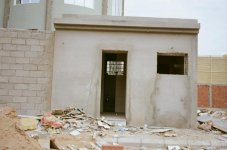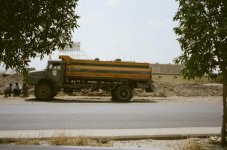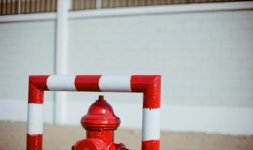mob81
Well-known
that was from my first couple of rolls "attached" Those were just test shots.....nothing special.
the colors look yellowish and I hope that's the developer's poor skills or my poor shooting skills.....Kodak Max 400 and Fuji Reala.
I was so excited but when I saw the result was disappointing.....:bang:
Or hopefully the scanning was BAD!?!?
Please give me your valuable inputs because I'm sure it's not the 35mm Film "at least not the REALA which considered amazing"
I've seen pics here and on the web and was sold to try films, color and B&W, and I know it's way better than that.
Voigtlander R3A w/ Zeiss 35mm 2.8 ZM
the colors look yellowish and I hope that's the developer's poor skills or my poor shooting skills.....Kodak Max 400 and Fuji Reala.
I was so excited but when I saw the result was disappointing.....:bang:
Or hopefully the scanning was BAD!?!?
Please give me your valuable inputs because I'm sure it's not the 35mm Film "at least not the REALA which considered amazing"
I've seen pics here and on the web and was sold to try films, color and B&W, and I know it's way better than that.
Voigtlander R3A w/ Zeiss 35mm 2.8 ZM
Attachments
Juan Valdenebro
Truth is beauty
Are you used to shoot color negative film? I mean, if processing at a lab, do you know how to meter to saturate color overexposing? If not sure, it could be a good idea for you to make sure you expose it correctly using lab development first, and then, develop it yourself... Your images look a bit wrong, that's right, but as they're just a digital version of a negative, it's not easy to be sure if there was a developing on a scanning problem...
Cheers,
Juan
Cheers,
Juan
payasam
a.k.a. Mukul Dube
Shooting technique cannot introduce a yellow cast. The C-41 process is standardised, and labs seldom go wrong. The most likely culprit is the scanning. I must say, though, that -- apart from the unexciting subjects -- I do not see much wrong with these photos.
mob81
Well-known
charjohncarter
Veteran
If they have a yellowish cast, it would be scanning, as they say above. Like payasam says the development could be bad but most likely scanning. I've had very few if any film manufacturing mess ups (in fact I can't think of any in 50 years). I have had a goofed development but very uncommon I'd say, and it always was at a cheap place. Now scanning, I've had too many bad jobs to count. Either do it yourself (scan), get to be a expert on PS, or your last choice is to live with it.
Underdog
Member
Open an image in Photoshop, go to Image>Adjustment>Levels (Ctrl+L). When Levels dialog box appears, you will see a drop-down list named Channel. By default all three channels are selected (RGB). Instead, choose the Red channel. Under histogram you will see white (on the right) and black (on the left) sliders. Move them both towards the center, just about where histogram is starting to ascend. Repeat the same for Green and Blue channels.
Your negatives are well developed, and scanning is not that bad. It's just that with any digital image you have to do a little postprocessing.
If you have any questions just ask.
Your negatives are well developed, and scanning is not that bad. It's just that with any digital image you have to do a little postprocessing.
If you have any questions just ask.
Attachments
Last edited:
oftheherd
Veteran
And don't forget there may have been a lot of yellow-brown reflections from the scene itself. You did say you were in Saudi.
Ronald M
Veteran
Color balance in the scanning step is the culprit. Labs can not hit the color balance when making prints also and introduce a color cast.
When working with a knowledgeable lab, I put a MacBeth color checker as the first frame and tell them to set up on that and run the rest without corrections. The down side is if the exposures are off or you move to non sun or flash areas, ie shade or indoors, the color will be uncorrected.
All said, the lab should have gotten the color better. The problem is there are no reference or memory colors to guide them except for the last of the first three.
This is why I provide the reference color sample.
They may not be set up for Reala which is an amateur film and perhaps they would do better with Kodak Portra or have them suggest a film.
All said and done, this is why I have my own darkroom and now scanner etc. Heresy to say here, but a digital camera gives you a perfect digi file without the intervening human/machine interface and basically, everything is on color straight from the camera.
Set it daylight or shade or tungsten or wherever you are. If you shoot RAW, you can correct later in the comuter with no loss.
From the examples shown only #3 is really unacceptable. The rest may be off, but I can`t see it and therefore a scanner operator can`t either.
When working with a knowledgeable lab, I put a MacBeth color checker as the first frame and tell them to set up on that and run the rest without corrections. The down side is if the exposures are off or you move to non sun or flash areas, ie shade or indoors, the color will be uncorrected.
All said, the lab should have gotten the color better. The problem is there are no reference or memory colors to guide them except for the last of the first three.
This is why I provide the reference color sample.
They may not be set up for Reala which is an amateur film and perhaps they would do better with Kodak Portra or have them suggest a film.
All said and done, this is why I have my own darkroom and now scanner etc. Heresy to say here, but a digital camera gives you a perfect digi file without the intervening human/machine interface and basically, everything is on color straight from the camera.
Set it daylight or shade or tungsten or wherever you are. If you shoot RAW, you can correct later in the comuter with no loss.
From the examples shown only #3 is really unacceptable. The rest may be off, but I can`t see it and therefore a scanner operator can`t either.
Leigh Youdale
Well-known
As Payasam says, they're not so bad. What is it exactly that you're not satisfied with?
Things to check:-
Fresh film (not affected by Saudi heat) - how do you store and transport it?
Slight underexposure to increase saturation of colours - watch out with wide lenses - the inbuilt exposure meter will gather info from the entire scene including the sky and you might need to use the exposure adjustment available on the Bessa. Next time I'd suggest bracket the shots with one of the exposures reduced by half a stop from 'standard' reading. If that's too much you can try increasing the ISO setting on the meter by 1/3rd stop, but that's fiddly when you're bracketing.
Reflected light in your environment may well have a yellow cast and that will have to be dealt with in the actual scanning or more likely in post production software.
Things to check:-
Fresh film (not affected by Saudi heat) - how do you store and transport it?
Slight underexposure to increase saturation of colours - watch out with wide lenses - the inbuilt exposure meter will gather info from the entire scene including the sky and you might need to use the exposure adjustment available on the Bessa. Next time I'd suggest bracket the shots with one of the exposures reduced by half a stop from 'standard' reading. If that's too much you can try increasing the ISO setting on the meter by 1/3rd stop, but that's fiddly when you're bracketing.
Reflected light in your environment may well have a yellow cast and that will have to be dealt with in the actual scanning or more likely in post production software.
Share:
-
This site uses cookies to help personalise content, tailor your experience and to keep you logged in if you register.
By continuing to use this site, you are consenting to our use of cookies.





